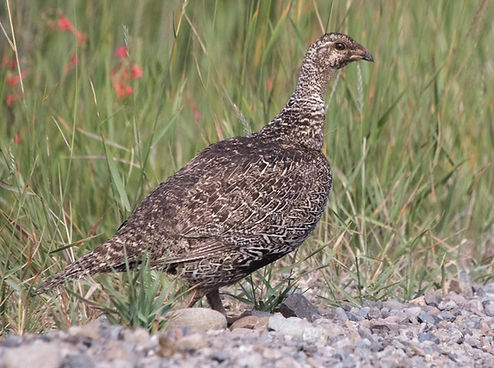
Gunnison Sage-Grouse
Gunnison Sage-grouse
Gunnison sage-grouse, or Centrocercus minimus, is a type of sage-grouse that live near the Colorado River in Colorado and Utah, though historically they lived in New Mexico and Arizona. However, nowadays most Gunnison sage-grouse (about 4,000 of the remaining 5,000) live in the Gunnison basin, a geological “basin” between mountains.
Because they’re quite similar, it wasn’t until the 1970s that scientists realized the differences between sage-grouse in the Gunnison basin and other sage-grouse like the Greater sage-grouse, which occur in other parts of North America. Gunnison sage-grouse are two thirds the size of Greater sage-grouse.
Both male and female Gunnison sage-grouse have similar fluffy, white feathers on the neck. Like Greater Prairie chickens, male sage-grouse have a flamboyant and extravagant mating dance, where they flaunt their wings and voice many noises using thor pouches and air sacs. Mating dances happen in the spring, in breeding grounds called leks.
Gunnison sage-grouse start nesting around April and may continue up to July. About 38% of birds that hatch will survive the summer. Females are slightly more likely to survive because of their less obvious and predator-attracting feathers.
In the winter, Gunnison sage-grouse live in flocks (15-100 birds). Flocks usually only have all females or all males. Wintering birds eat almost entirely sagebrush.
Why Are They Endangered?
Gunnison sage-grouse are listed as threatened and have been called one of the 10 most endangered birds in North America (Audubon Society 2006). The main reason why this bird is endangered is habitat loss and the degradation of the habitat they have. Gunnison sage-grouse has lost so much habitat in past years that now they cover only 7% of their historical habitat; only about 1,822 square miles out of their original 21,276 square miles.
Gunnison sage-grouse, like all animals, require sufficient habitat. Gunnison sage-grouse in particular need a lot of sagebrush, plenty of different grasses, and healthy wetland and water ecosystems. Sagebrush in particular is needed for winter.
Gunnison sage-grouse habitat is often destroyed because of roads and other urban developments. Oil and gas companies also shrink the habitat Gunnison sage-grouse can use to live on.
The habitat that is still there is split and fragmented by roads, powerlines, and fencing, and is drained by chemical land treatments, excessive livestock grazing, drought, and more deer, which eat shrubs sage-grouse need. Baby sage-grouse need a healthy habitat full of vegetative cover to successfully survive, and it is easier for Gunnison sage-grouse, especially young Gunnison sage-grouse, to be hunted without proper forbs and grasses to act as cover.


Effects
Gunnison sage-grouse are important to the environment because they show what is happening to the plant species and habitat they live in. Because Gunnison sage-grouse depend so heavily on sagebrush, the fact that they are endangered because they are losing habitat with suitable amounts of sagebrush shows that sagebrush habitat is declining. The sagebrush ecosystem is important to so many creatures, including the Gunnison sage-grouse, and we are degrading it.
The predators of Gunnison sage-grouse like golden eagles, several hawks, coyotes, foxes, weasels, corvids, and badgers all depend on the sage-grouse and the sagebrush ecosystem to survive. All animals and species are connected and are affected by the sagebrush ecosystem’s fragmentation.
What Can You Do?
The Gunnison Climate Working Group is trying to reduce the effects of global warming on people and nature in the Gunnison Basin. They are trying to adapt the wetland to be more resilient in the basin. Colorado Parks and Wildlife are trapping and transplanting birds from the Gunnison basin to other places to increase genetic diversity and increase populations.
You can raise awareness for Gunnison sage-grouse, and raise money and donate to the World Wildlife Fund or the websites below.
sources cited
"Gunnison Sage-Grouse." U.S. Fish and Wildlife Service, www.fws.gov/mountain-prairie/es/gunnisonSageGrouse.php. Accessed 13 May 2020.
"Gunnison Sage-Grouse." U.S Fish and Wildlife Service, www.fws.gov/sagebrush/wildlife/gunnison-sage-grouse/. Accessed 13 May 2020.
"Gunnison Sage-Grouse." Western Colorado University, www.western.edu/Gunnison-sage-grouse. Accessed 13 May 2020.
“Gunnison Sage-Grouse.” All About Birds, https://www.allaboutbirds.org/guide/Gunnison_Sage-Grouse/id#. Accessed 27 June 2020
*all pictures used with permission, and/or taken from the sites above.


